Quantitative simulations of ratchet potential in a dusty plasma ratchet
Shuo Wang(王碩), Ning Zhang(張寧), Shun-Xin Zhang(張順欣), Miao Tian(田淼),Ya-Wen Cai(蔡雅文), Wei-Li Fan(范偉麗), Fu-Cheng Liu(劉富成), and Ya-Feng He(賀亞峰)
College of Physics Science and Technology,Institute for Life Sciences and Green Development,Hebei University,Baoding 071002,China
Keywords: dusty plasma,ratchet potential
1. Introduction
Brownian ratchets refer to a structure consisting of periodical and asymmetrical units in one or two dimensions.[1–9]It can rectify the random Brownian motion of particles to generate a directed steady-state flow of particles, and has attracted great interests from diverse areas of science and technology,such as the Hamiltonian quantum ratchet,[5–7]the optical rocking ratchet,[8]and the organic electronic ratchet.[9]The ratchet potential of Brownian ratchet breaks spatial symmetry due to the asymmetrical structure. Driven by nonequilibrium perturbations such as zero-mean external biases,Brownian particles can be rectified into directional movement.The particles could be either without interaction, such as the colloidal spheres in a silicon membrane,[10]or with interaction among them,such as the electron in organic electronic ratchets.[9]Complex interaction among the charged particles gives rise to many novel phenomena such as the reversal of particle flow.
Recently,we experimentally observed the rectification of charged dust particles in a dusty plasma ratchet.[11,12]The dust particles can directionally flow in positive or negative direction along the saw channel just by changing simply the gas pressure. In this process, a ratchet potential could appear to dominant the directional transport of dust particle. The asymmetrical orientation of the ratchet potential should depend on the discharge condition. Here,we perform quantitative simulations to find this ratchet potential along the saw channel in detail. Numerical simulations show that the potential at the balance position of dust particle exhibits ratchet-like distribution along the saw channel. Using molecular dynamics simulations, we reproduce the experimental observations that dust particles can flow in opposite directions at different gas pressures.
2. Experimental setup
In order to obtain the ratchet potential we design a model of dusty plasma ratchet in which two gears are placed concentrically on the horizontal lower electrode as shown in Fig. 1.The two gears have the same asymmetrical orientation and sawtooth number, and enclose a saw channel between them.The width of the saw channel changes periodically and asymmetrically along the saw channel.Here,we choose two typical cross sections cutting vertically the saw channel inr–zplane just at different azimuthal positions,which are the widest oneΩwatθwand the narrowest oneΩnatθn. Within each sawtooth,due to the periodicity and the asymmetry,Δθw+Δθn=Θ, Δθw/Δθn= 2/13, hereΘ= 2π/24 is the period of the gears. One of the typical cross sections is shown by the color section in Fig.1. This dusty plasma ratchet is placed in a vacuum chamber filled with argon gas and plasma is generated by capacitive coupling discharge(13.56 MHz).The dust particles used are monodisperse polystyrene microspheres with a radius of 11.5 μm. The rectification and reversal of the dust particles in the plasma ratchet is accomplished by changing the pressure and the discharge power.
The 3D distributions of plasma parametersΠ(r,z,θ)are actually hard to calculate directly at present. Here, we adopt two steps to resolve this issue as shown below. Firstly,we perform COMSOL[13]simulations in ther–zplane to obtain the plasma parametersΠ(r,z)in the two typical cross sectionsΩwandΩn. Secondly, the plasma parameters in other cross sections besides the two typical cross sections can be interpolated in term of a double-sine function because the dependance of plasma parameters onθcan be fitted well by the double-sine function.[11]
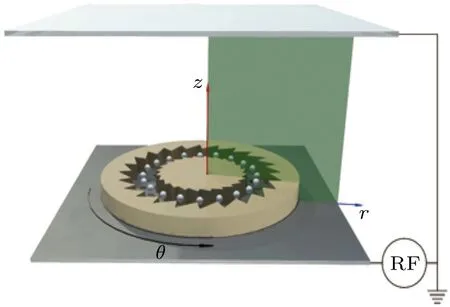
Fig. 1. Diagram of the dusty plasma ratchet. Two gears with asymmetrical sawtooth are placed concentrically on the lower electrode and enclose a saw channel in which dust particles flow persistently in θdirection. The gray region illustrates one of the two typical cross sections Ωn,w cutting vertically the saw channel in r–z space, in which numerical simulations are performed.
3. Experimental results
Figure 2 shows the distributions of electron densityne(r,z)and electric potentialU(r,z)inr–zplane in the widest cross section. It can be seen that the plasma can deepen into the saw channel and the equipotential curves near the saw channel exhibit parabolic-like distribution which can confine charged dust particle to the center of the saw channel. Based on the calculated plasma parameters the chargeQof dust particle can be obtained using the orbital-motion-limited theory,Q~104e. Then, the acting force on dust particle in the two typical cross sections can be analyzed as shown below.
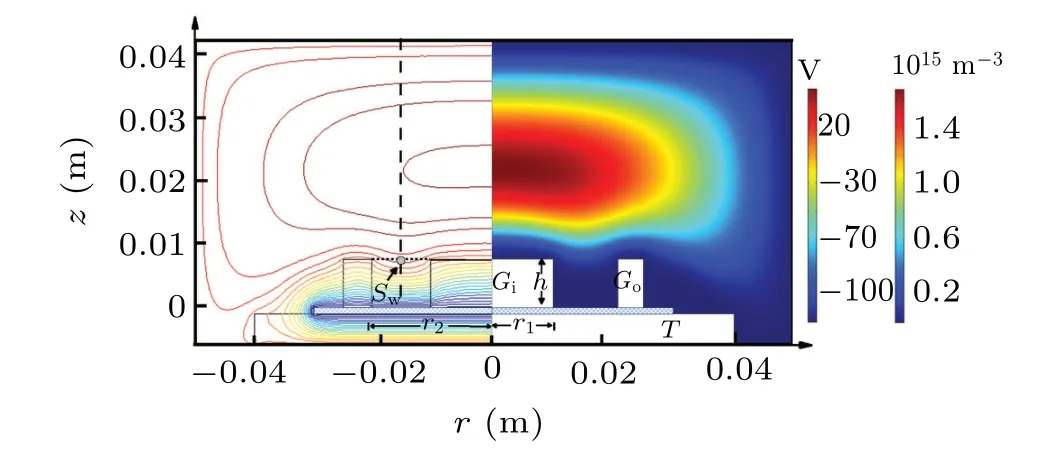
Fig. 2. Distributions of electron density (right) and potential (left) in cross section Ωw in r–z plane. Gi, Go, and T represent the cross sections of the inner and outer gears, and the teflon block, respectively;r1 =11 mm, r2 =21 mm, and h=9 mm. Grey stripe indicates the powered electrode. Spot Sw indicates the balance position of dust particle in the saw channel. Boundaries of the chamber are grounded. Gas pressure 40 Pa and rf power 10 W(V0=39 V,Vdc=-112 V).
We consider the acting force on dust particle in therandzdirections,respectively. In the radialr-direction,because the equipotential curves of different values all exhibit parabolic distribution as shown in Fig. 2, the charged dust particle will be definitely confined to the center of the saw channel although the dust particle could be levitated at different heights. Figure 3 shows the balance positions of dust particle in the radial and vertical directions,respectively,in which the dashed linesSrindicate the balance positions of dust particle at different heights. It shows that,in both the widest and narrowest cross sections,dust particle is confined to the center of the saw channelrc≈15.1 mm.
In the vertical direction,the gravity of dust particle is balanced by the electric field in the sheath of the lower electrode.The balance height of dust particle at different radii of the saw channel is indicated by the solid curvesSzin Fig. 3. Obviously, from the individual balance position in the radial and vertical directions, the intersection of the solid curveSzand the dashed lineSris the actual balance position of dust particle in the saw channel.It can be seen that the balance heightSnof dust particle in the narrowest cross section is always higher than thatSwin the widest cross section even if the discharge condition is different. The difference Δzbetween the two balance heightsSnandSwis in the range from about several tens to a few hundreds of μm,depending on discharge conditions.It is clear that,besides the two typical cross sections,the balance heights in other cross sections would be located between the two points,i.e.,the maximumSnand the minimumSw.
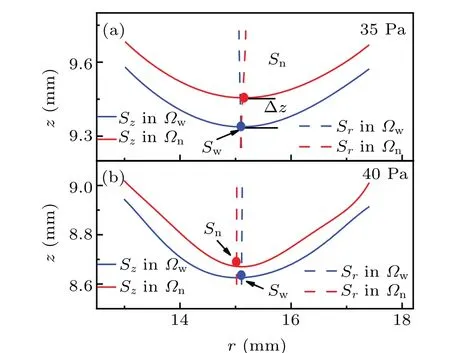
Fig.3. Balance positions Sn and Sw of the charged dust particle in the two typical cross sections Ωn and Ωw, respectively. Solid curves represent the balance height of dust particle in z-direction above the lower electrode at different radii. Dashed lines indicate the balance position in r-direction at different heights. Thus,the intersections of Sn and Sw of the solid curves and the dashed lines are the actual balance positions of the dust particle in the vertical section. Notably,Sn in the narrowest cross section Ωn is always higher than Sw in the widest cross section Ωw. The higher the gas pressure is, the lower the balance position is.The radius of the dust particle is rd=11.5 μm.
We next focus on the potential at the balance position of the dust particle. Figure 4 shows the distribution of potential along the vertical dashed line passing the balance positionSn,win Fig. 2. It can be seen that the potential drops dramatically across the sheath of the lower electrode. From the calculated balance heightSn,win Fig. 3, we mark the balance positionSn,wof dust particle as colored spots as indicated in the enlarged view in Fig. 4, and then can find the potential at the balance height. It can be seen that the balance height of dust particle at higher gas pressurep=40 Pa is lower than that at lower gas pressurep=35 Pa,and the balance heightSnin the narrowest cross sectionΩnis always higher than thatSwin the widest cross sectionΩwfor the two gas pressures. However,we find that the potentialUnatSnis smaller than thatUwatSwatp=40 Pa,whereasUnatSnis larger than thatUwatSwatp=35 Pa, which results in the reversal of asymmetrical orientation of ratchet potential at the two gas pressures as shown later.

Fig.4.Electric potential in the vertical dashed line in Fig.2.Solid spots in the enlarged view indicate the balance positions Sn and Sw,where the potentials are somewhat different so as to give rise to a ratchet potential along the saw channel. Un >Uw at 35 Pa, whereas Un <Uw at 40 Pa,which illustrates that the asymmetrical orientation of the ratchet potential reverses at the two gas pressures. Parameters are the same as those in Fig.3.
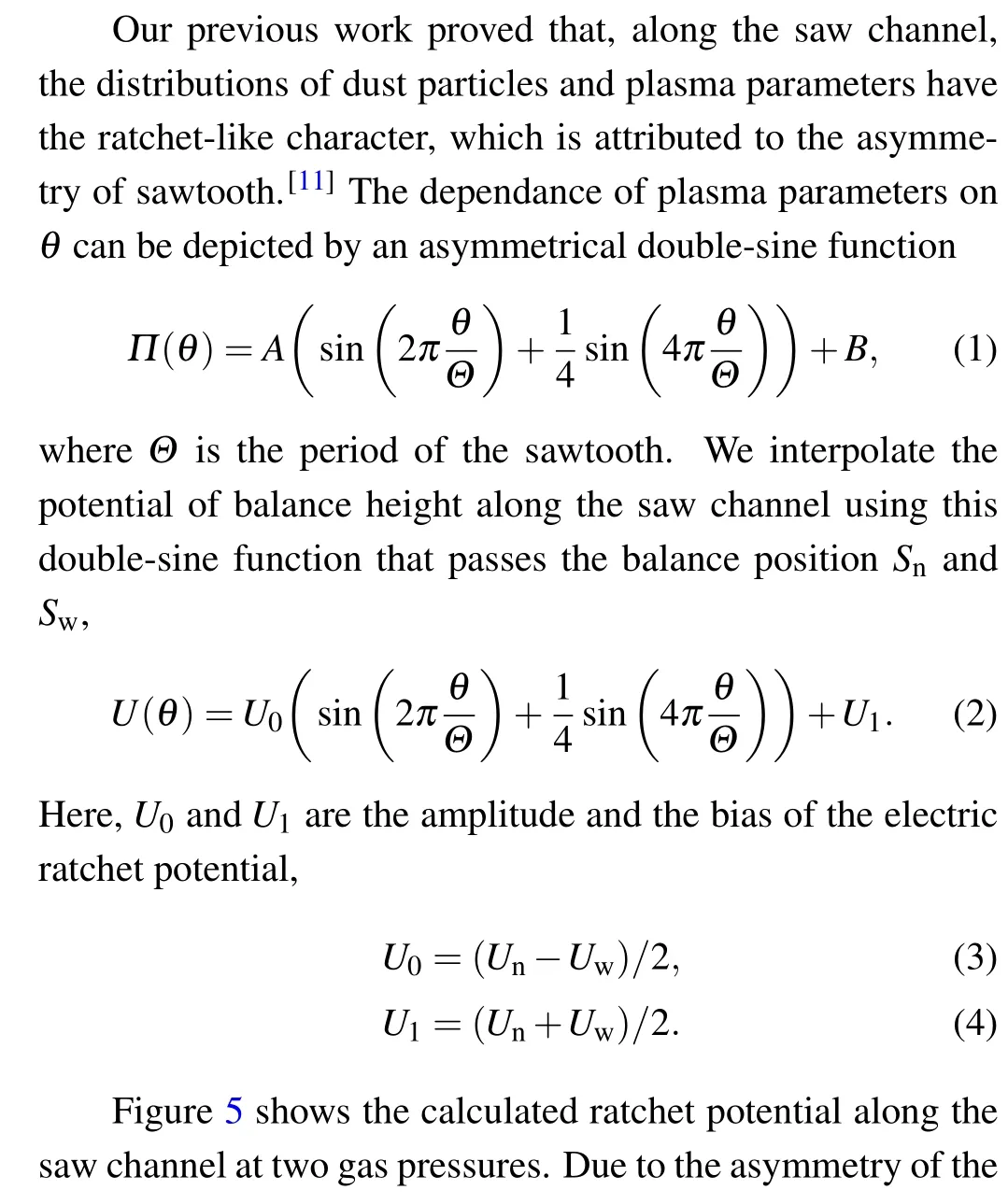
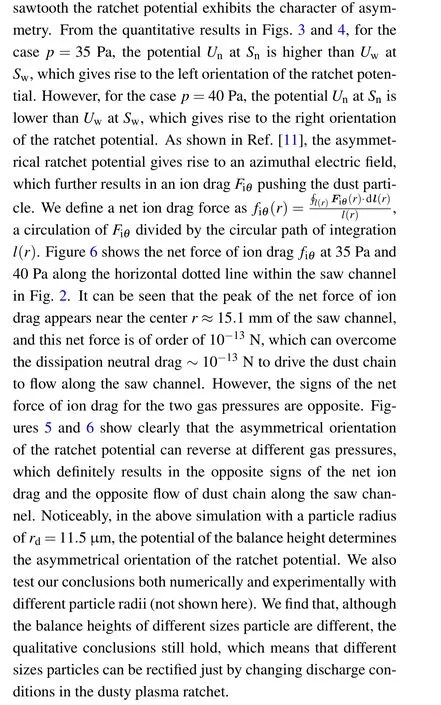
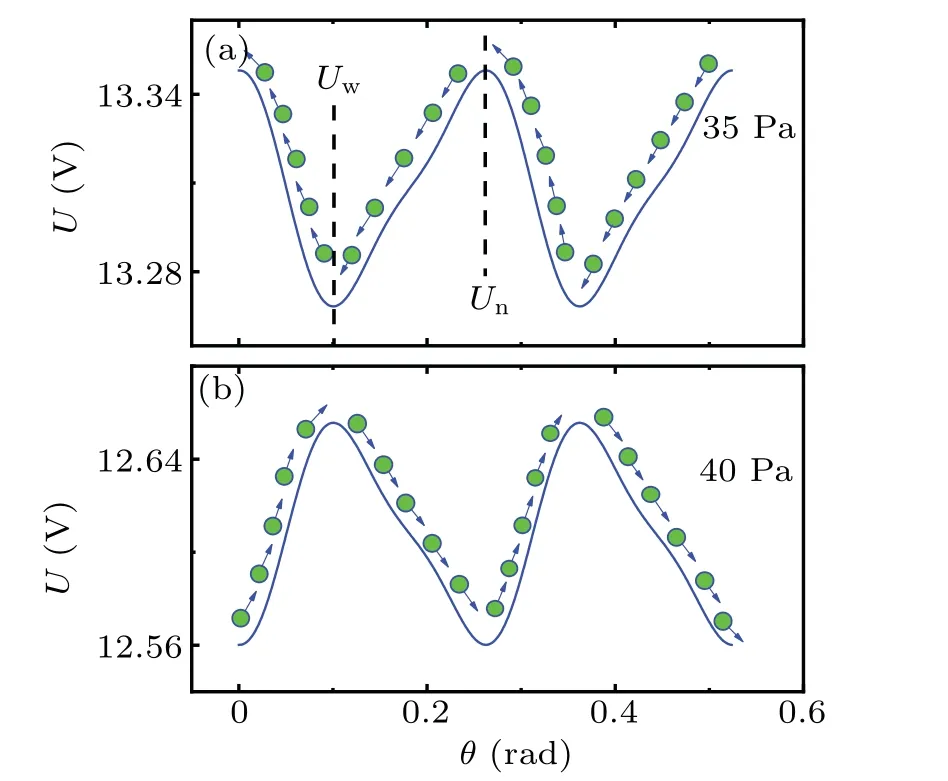
Fig.5. Electric potential in the balance position of dust particle within two sawteeth along the saw channel. The electric potentials distribute asymmetrically and the orientation of this ratchet potential at 35 Pa is opposite to that at 40 Pa. Green solid spots represent the dust chain flowing in the arrow direction. Un and Uw are the potentials at balance heights in Fig.4.
In our simulations, we obtain the ratchet potential along the saw channel by interpolating the numerical calculation in two typical cross sections. In order to verify the validity of the interpolation, we also perform simulation in other cross section between the two typical cross sections. We find that the balance height of dust particle in this test cross section is located betweenSnandSw, and the potential at this balance height is also located betweenUnandUw. Our tested results clearly show that these interpolation results are the same for the simulation results.
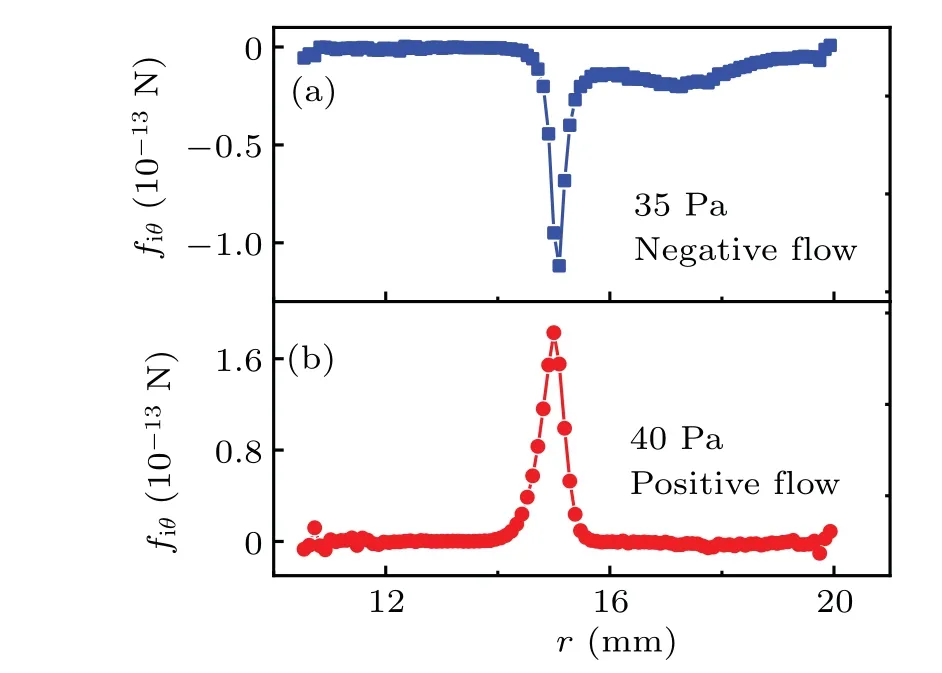
Fig. 6. Radial distribution of the net ion drag force, with fiθ(r)<0(fiθ(r)>0)leading to the negative(positive)flow of the dust particles.The peaks of curves appear around the center of the saw channel at r ≈15.1 mm, where the dust particles distributed. Parameters are the same as those in Fig.5.
4. Conclusion
In summary,we have quantitatively study the asymmetrical ratchet potential along the saw channel of the dusty plasma ratchet. Using numerical simulations, we firstly obtain the plasma parameters in two typical cross sections cutting vertically the saw channel, and find out the balance positions of charged dust particle in the two cross sections. The potentials at the two balance positions are somewhat different. Then,in the azimuthal direction along the saw channel, we deduce a ratchet potential of balance position of dust particle through interpolation with a double-sine function. We further find that the asymmetrical orientations of the ratchet potential and the signs of the net force of ion drag for different gas pressures are opposite. Numerical results explain quantitatively the reversal of dust flow in the dusty plasma ratchet under different discharge conditions.
Acknowledgements
Project supported by the National Natural Science Foundation of China(Grant Nos.11975089 and 11875014),the Interdisciplinary Research Program of Natural Science of Hebei University (Grant No. DXK202010), and the Hebei Natural Science Fund(Grant Nos.A2021201003 and A2021201010).
- Chinese Physics B的其它文章
- Ergodic stationary distribution of a stochastic rumor propagation model with general incidence function
- Most probable transition paths in eutrophicated lake ecosystem under Gaussian white noise and periodic force
- Local sum uncertainty relations for angular momentum operators of bipartite permutation symmetric systems
- Quantum algorithm for neighborhood preserving embedding
- Vortex chains induced by anisotropic spin–orbit coupling and magnetic field in spin-2 Bose–Einstein condensates
- Short-wave infrared continuous-variable quantum key distribution over satellite-to-submarine channels

